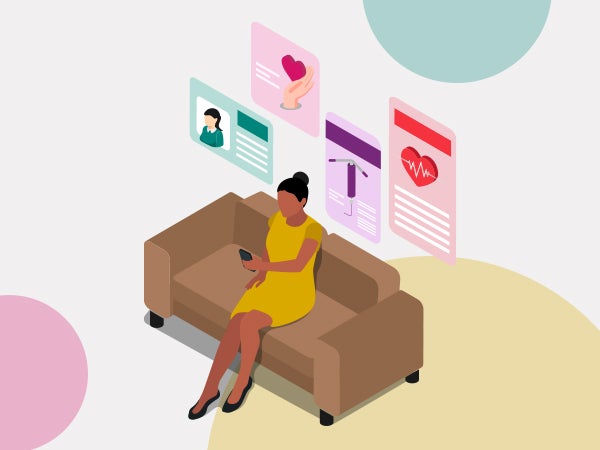
Womanhood is multi-faceted, yet in healthcare media, the representation of women and those who identify as women has remained static—and many feel underrepresented, according to a study conducted by WPP and SeeHer. How can the industry help change that?
Womanhood is dynamic and multi-faceted, yet in healthcare media, the representation of women and those who identify as women has remained static—and many feel underrepresented, according to a study conducted by WPP and SeeHer.
Nearly half (47%) of the women and nonbinary individuals who participated in the study said they believe that media shies away from talking about women’s health issues.1 That finding indicates not only a severe gap in addressing women’s healthcare needs, but also missed opportunities to engage with and help improve the long-term health outcomes of female-identifying patient populations.
The study’s results suggest that communications about women’s health can—and should—better represent their needs across areas ranging from weight and mental health to reproductive care. Indeed, there are several distinct opportunities for the industry to begin making improvements, notes Jordan Osborne, Lead Client Experience Manager at Phreesia.
“Women have many kinds of shared experiences, but we are far from a homogenous group,” Osborne says. “Brands must approach women as individuals with their own unique beliefs, thoughts and experiences if they want their campaigns to connect with and empower women across the board.”
Here are four ways to improve the representation of women in healthcare media and reach them with authentic messaging that speaks to their unique needs and experiences.
1. Understand research disparities in women’s health
Until the 1990s, women in the U.S. were not typically included in clinical research.2 While their participation in clinical trials has since increased, women’s health conditions still represent only 1% of healthcare research outside of oncology.3 That disparity is particularly marked in cardiology studies, Osborne says. Early cardiovascular-disease research focused primarily on men’s physiological symptoms, leaving the different symptoms that often present in women off the radar. As a result, women are 50% more likely than men to be misdiagnosed following a heart attack and more likely than men to die from one.4
“Heart disease is the leading cause of death in the U.S., and yet we are still basing care and treatment decisions on outdated studies that excluded more than half of the population,” Osborne says. “Life sciences companies have an opportunity to evolve not only how they are conducting their research, but also the way they communicate new learnings, outcomes and information to both healthcare providers and their key patient populations.”
2. Rethink segmentation
Most brands currently segment messaging to women based on their demographics, but WPP’s study revealed that the physical aspects of womanhood are less important to women than their self-perception and personal beliefs. Study participants said the most significant parts of their identities relate to their personality traits (34%), beliefs and values/culture (19%), roles and titles (13%), sexual orientation and relationship status (11%), followed by physical traits (9%) and interests (5%).
“Women are often portrayed based on their relation to other people—as mothers, daughters, friends, caregivers—however, it’s very important not to flatten their experiences into those roles,” Osborne says. “Of course, brands can lean on those shared experiences to help build a connection, but it’s equally important to include the unique and specific stories that make them who they are into representation.”
3. Leverage an omnichannel messaging approach
It’s crucial to embrace an omnichannel approach that delivers relevant messaging to women at the right moments in their healthcare journey, since their needs vary widely based on their day-to-day roles. For example, brands may tailor their point-of-care messaging for the “substantial proportion” of women who lean on their obstetrician/gynecologist for primary care and do not visit a traditional primary-care provider regularly.5 Additionally, a significant number of women face greater time constraints because they work two jobs: one in the labor market and the other managing their home and family responsibilities.
“We have to think about the different aspects of a healthcare journey and the fact that no two journeys are identical,” Osborne says. “It’s important to have an omnichannel strategy that delivers the right message at the right place, while also intercepting women during the right time—whether they are actively thinking about their healthcare, or to inspire action when they are deprioritizing it.”
4. Develop authentic content
Brands also have an opportunity to break taboos around women’s health and to deliver the authentic content that women prefer, the report found. Among women’s health concerns, the women in the WPP study said that reproductive health is the least likely topic to be addressed in media and advertising. More than half (52%) of surveyed women reported that miscarriage is not depicted in content, and 45% reported that periods are not accurately portrayed.
To feel authentic, content should also be inclusive and represent women from all backgrounds. “Brands can drive connection by involving women from diverse and underserved communities in creative development from conception through execution,” Osborne says. That means taking the time to interview women about their different experiences and validating messaging with real people to make sure it resonates, she adds. It also means leading with a diverse approach to media planning rather than including D&I as an afterthought.
“These steps can go a long way toward ensuring our messaging reflects our audience’s unique needs and resonates with their individual beliefs and shared experiences,” Osborne says.
Find out how Phreesia can help you better connect with patients and deliver relevant health content that meets their needs.
References:
1 “Health On Her Terms,” WPP and SeeHer, November 2022.
2 Zucker I, Prendergast BJ. Sex differences in pharmacokinetics predict adverse drug reactions in women. Biol Sex Diff. 2020;11(32). https://doi.org/10.1186/s13293-020-00308-5
3, 4 “Unlocking opportunities in women’s healthcare,” McKinsey & Company, Feb. 14, 2022.
5 Mazzoni S et al. Patient Perspectives of Obstetrician-Gynecologists as Primary Care Providers. J Reprod Med. 2017;62(1-2):3-8.


